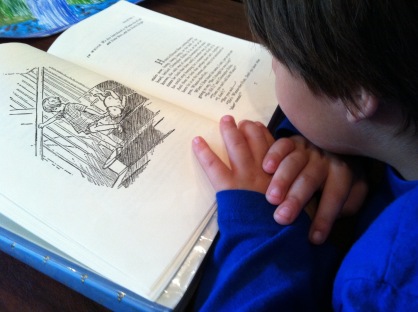copyright©donnaesgro
*
Taking the step from picture books to chapter books is a natural process for the early reader. Just as children gradually grow from learning almost exclusively through the senses into more abstract thinkers, they will be able to understand and enjoy the process of combining the technical skills of reading with their growing use of imagination to create their own wondrous images from words. Let your child’s interests guide your choice of books. Typically, throughout early childhood, a child goes through heightened stages of interest in which certain concepts fascinate him for an indefinite period. Look for early chapter books with these themes. A child will be more likely to keep the sustained interest that chapter books demand if he is curious about the subject.
Be wary of early chapter books that pander to what some publishers think children will ask parents to buy. Often, though not always, these books are churned out, not well written, and designed so that children are encouraged to look at the illustrations and read just snatches of dialogue or captions. I think that children deserve more respect. The general rule here is to look over any book you are not familiar with, before you hand it over to your child.
I like the My Father’s Dragon trilogy by Ruth Stiles Gannett. In addition to being a classic story of heroism and adventure, each novel is short (about eighty pages) and printed with larger typeface than the norm, which makes it an inviting challenge for a young reader. Other excellent choices, are Cynthia Rylant’s Lighthouse Family series and Johanna Hurwitz’ Park Pal Adventures. All of these early chapter books have lovely illustrations that help to create a bridge between books with mostly pictures and books with mostly words.
Although a child has begun to develop the skills to be able to read and comprehend chapter books, don’t give away all of his picture books. Children find these familiar stories soothing and will often turn to them for enjoyment as they are transitioning. Chapter books demand much of an early reader who may still be struggling with technical skills and unused to the increased attention span that a chapter book requires.
But, by no means wait to introduce chapter books until your child has mastered the skills to read by herself. Begin the transition by reading from some of the books that were your favorites. Your child will be excited by the idea that you read this very same story when you were little. Continue to read interactively, as you have done with picture books, stopping frequently and asking such questions as, “What do you think Piglet will do now?”
Interactive reading brings a deeper and more personal understanding to the story. It is certainly all right to paraphrase – part reading, part telling – from time to time to help comprehension. I would rather do this than read an abridged version as I believe that an introduction to unusual vocabulary is one of the delights of literature. When reading a particularly obscure book, with antiquated wording, such as Just So Stories by Rudyard Kipling, this approach is advisable or you may completely lose your listener. However, part of the joy of chapter book reading is being exposed to interesting use of language and different ways of seeing, so be judicious before paraphrasing such beauteous language as the following:
“In the sea, once upon a time, O my Best Beloved, there was a Whale, and he ate fishes. He ate the starfish and the garfish, and the crab and the dab, and the plaice and the dace, and the skate and his mate, and the mackereel and the pickereel, and the really truly twirly-whirly eel.” (Rudyard Kipling)
Even if a child does not fully grasp the meaning of each word, he will, undoubtedly, be enchanted by the very sound and rhythm of the language, especially if you are. Children have acute sensibilities and know when an adult is truly enjoying the time spent reading or is just performing another necessary chore. So, pick a time (everyday) in which you are unhurried and able to relax with your child over a book, though it may only be 15 minutes before bedtime, it is a very worthwhile time together that will help your child to form deep and positive attitudes towards literature.
